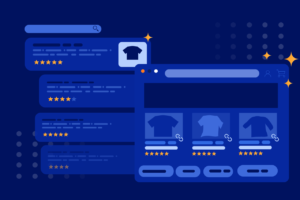The opportunity for eCommerce businesses to grow globally has never been bigger.
Today, the global eCommerce market sits at $6.1 trillion. And by 2026, it’s forecast to reach an astronomical $8.1 trillion.
But how can you claim a slice of this ever-expanding pie?
Enter: International eCommerce SEO.
International SEO ensures your eCommerce or Shopify site can rank well in different countries. It delivers a tailored shopping experience to customers, no matter where they are or what language they speak. The result is more visibility and traffic (and Benjamins!) for your online store.
Today, we’ll dig into the nitty-gritty of international eCommerce SEO and explore what it takes for your Shopify site to take over the world.
First, some basics.
What Is International eCommerce SEO?
International SEO for eCommerce is the practice of improving your online store’s organic search visibility across multiple countries and regions.
It involves creating several versions of your site to cater to the specific languages, currencies, and cultural tastes of different target markets. It also involves configuring your eCommerce site so search engines know which version they should serve users based on their language or location.
A well-designed international SEO strategy will help expand the reach of your Shopify store to a worldwide audience. This will boost your revenue, diversify your customer base, and lay the foundations for long-term global growth.
What’s the Difference Between Local SEO, National SEO, and International SEO?
You need a different SEO strategy to reach local, national, or international markets through organic search. This is because customer preferences and behaviors can vary considerably from one place to the next.
Local SEO aims to increase your site’s visibility for local search results. It’s especially useful for brick-and-mortar businesses that want to attract more nearby customers to their physical stores or locations.
The focus of national SEO is to boost your site’s visibility for searches within a given country. All keyword optimization efforts, content creation, and choices relating to language and currency will reflect the interests and norms of that particular region.
Meanwhile, international SEO seeks to improve your site’s organic visibility worldwide. The aim is to ensure your site effectively caters to the diverse cultural preferences, local languages, and regional currencies of your global audience.

What to Consider Before Developing an International SEO Strategy
If your business sells to customers who live in different countries or speak other languages, chances are you need an international SEO strategy.
But which new international markets should you target? And how should you approach them?
Start by reviewing the state of your existing website. Check Google Analytics to see which other countries and languages drive the most organic traffic and conversions on your site. Later, you can use this data to prioritize your localization efforts. It’s also worth using a SERP analysis tool to see how well your pages rank in other countries.
Next comes market research. Take the time to study consumer trends and behaviors in different regions, including which currency and language they’re most likely to use. You should also analyze how other players operate in those markets, looking at the volume of traffic they receive, the personas they cater to, and how they tailor their pages accordingly.

After identifying the most promising markets for your business, you should consider whether you have the resources needed to succeed in the global marketplace. For example, do you have the capacity to ship products internationally, handle different currencies, and translate content into different languages?
If yes, you’re ready to develop your own international SEO program or hire the support of a dedicated B2B or DTC eCommerce SEO agency.
6 Must-Haves for Your International Shopify SEO Strategy
Now let’s look at some essential ingredients of a world-beating eCommerce SEO & Shopify SEO strategy.
1) The right domain structure
Setting up different versions of your Shopify store for each target market makes it much easier to cater to their distinct customer needs. But you’ll first need to decide on a suitable domain structure for your global site.
In most cases, we recommend using a generic top-level domain (gTLD) combined with subdomains or subfolders.
- gTLD (e.g., myonlinestore.com): This type of domain is not tied to a specific region or country. But you can combine it with subdomains or subfolders to target specific countries or languages.
- Subdomain (e.g., uk.myonlinestore.com): Subdomains are treated as distinct domains by search engines. This means the store for each target country will live on a dedicated subdomain.
- Subfolder (e.g., myonlinestore.com/uk/): Subfolders specify the relevant country code within the main domain. Since all store content usually exists on the same domain, this option is best if customer location doesn’t impact what products you can offer them.

Alternatively, you could use a country code top-level domain (ccTLD). In this setup, each version of your store has its own dedicated domain from one country to the next. For example, your German store domain might be myonlinestore.de, while the Canadian domain might be myonlinestore.ca.
Country-specific domains indicate that your business has an established regional presence, which can help you earn the trust of local customers.
However, ranking well for global search terms can be more challenging when you spread content across several domains.
So, we find that using a gTLD with subdomains or subfolders is often a simpler way to manage SEO efforts while also allowing for effective regional targeting.

2) Hreflang tags
Creating a dedicated domain, subdomain, or subfolder for each of your international stores doesn’t guarantee that search engines will display the correct version of your site to users.
For that, you’ll also need to implement hreflang tags. These are HTML attributes that instruct search engines about the language and geographical targeting of each page.
Hreflang tags are especially important for avoiding duplicate content issues when different versions of your store target markets that share the same language (like the US, New Zealand, and the UK).
They are also useful when you want to display a different version of your store to users within multilingual countries. For example, in Switzerland, where both French and German are spoken, hreflang tags can ensure search engines display the appropriate version based on the user’s language preferences.
Here’s an example of what an hreflang tag looks like:
<link rel="alternate" hreflang="en-gb" href="https://myonlinestore.com/uk/alternate-page" />And here’s a breakdown of what each part means:
- link rel=”alternate”: This says that the linked-to page is an alternate version of the current page.
- hreflang=”en-gb”: This describes the language and country associated with the alternate page. In this case, the “en-gb” language-country code tells search engines that the alternate page is an English version intended for UK audiences. Keep in mind that the country code is optional but can help with more precise targeting. (Here are the full lists of eligible language codes and country codes).
- href=”https://myonlinestore.com/uk/alternate-page”: This specifies the address of the alternate page.
💡 You can quickly generate multiple hreflang tags using this free hreflang generator tool by Aleyda Solis.
But what happens if none of your hreflang values match a user’s language or location? In that case, you can use the “x-default” placeholder to specify the default version of your page.
<link rel="alternate" hreflang="x-default" href="https://myonlinestore.com/default-page" />Finally, you should add a return link to your hreflang annotations to help search engines understand the equivalence between variants of a page.
So to indicate that our English page is equivalent to our French page, we would add reciprocal links to both pages.
English page:
<link rel="alternate" hreflang="fr" href="https://myonlinestore.com/fr/page" />French page:
<link rel="alternate" hreflang="en" href="https://myonlinestore.com/en/page" />Remember, search engines may struggle to distinguish between different versions of your site if you don’t have hreflang in place. This can lead to issues like content duplication (potentially harming your rankings), search engines displaying the wrong version of your site, and general user confusion.
3) International keyword research
You’ll need to conduct dedicated keyword research for each target market to maximize your exposure to local audiences.
Depending on where they live, customers use different words and phrases when searching for products and information—even if they speak the same language and search for the same thing. For example, when it comes to electronics, a US user is more likely to search “cell phone,” while a British user is more likely to search “mobile phone.”
In countries where English is not the native language, keyword research will let you identify the terms customers use when searching for products like yours. It will also help you target keywords that resonate most with international audiences while avoiding any sensitive phrases.
4) Translated and localized content
Once you’ve identified which keywords to target in different markets, you’ll need to translate and localize your new and existing content.
Here’s what you should translate across each of your country-specific stores:
- URL paths (if possible)
- Title tags
- Meta descriptions
- Header tags
- Category page copy
- Product page copy
- Navigation headers
- Footers
- Link anchor text
- Image text, file names, and alt tags
While you can use Shopify Apps like Weglot or Translation Lab to automate translation, we recommend using real-life translators for high-impact content to the extent your SEO and marketing budget allows. This is because humans are currently better than machines at “transcreation”—adapting content to the cultural nuances of the target audience while retaining the original message.
💡 Remember, if you’re targeting countries that speak the same language but have different spelling conventions (like “color” in the US vs. “colour” in the UK), you’ll also need to localize your language for each specific market.
More generally, you should produce targeted content that caters to the specific needs and preferences of local markets. For instance, content about deals related to July 4th may be relevant to U.S. audiences but not customers in Europe.
We can see this very example of location-conscious content on the Govee Shopify website. Their U.S. store features patterns of red, white, and blue, as well as U.S. flags as part of their 4th of July promotion, while the same section of their European stores shows their standard product line.


5) Canonical tags
Canonical tags prevent search engines from indexing instances of duplicate content.
ECommerce stores often have several pages that share the same or similar information, like product descriptions, size guides, and refund policies. When search engines encounter such duplicate content, they may rank just one of the pages at the expense of all the others.
Canonical tags prevent this problem by specifying which version of the page search engines should treat as the primary or “canonical” one. This tells search engines that the duplicated content is intentional and that they should funnel all ranking signals into the canonical version.
For example, Govee offers neon LED strip lights in various sizes. Each size option has its own URL variation but shares most of its content with all the other pages.


So, to prevent each version of the page from being indexed separately, BlendJet has implemented the following canonical tag across each page.


💡 When the same content appears across geographical variations of the same page, you can prevent duplicate content issues by implementing hreflang tags.
6) An international digital PR strategy
Lastly, no global eCommerce SEO program is complete without an international digital PR strategy.
As with domestic SEO, digital PR is key to building greater brand recognition and credibility in global markets. But with international SEO, you’ll need to build relationships with sites, publications, and influencers within each target country. This will help you reach a wider local audience and earn you more high-quality regional backlinks.
Keep in mind that you’ll need to develop distinct digital PR campaigns for each international market. There are several techniques you can use to increase regional coverage of your brand, such as:
- Cross-collaboration: Approach a relevant, high-authority publication with an article idea to publish on their site.
- Original research: Conduct country-specific research and share your findings with regional publications.
- Reactive PR: Add your brand’s unique perspective to a trending story on social media.
- Co-authored content: Team up with regional influencers or businesses to co-create content (like joint case studies, expert interviews, or co-written blog posts).
The Challenges of International eCommerce SEO
It’s hard to argue against the benefits of expanding your Shopify store to new international markets. But doing it right is no cakewalk.
First, you must conduct thorough market research in all new territories to gauge product demand and understand regional consumer preferences.
Then, you must meet the technical demands of targeting different markets, including building and maintaining a suitable domain structure, implementing hreflang tags for each page, and managing duplicate content.
You also have to manage content in multiple languages carefully, ensure that you cater to the cultural differences of each market, and spread the word about your new stores.
In light of these difficulties, it’s no surprise that many eCommerce businesses with global aspirations outsource the work to the pros.
Besides saving you time and resources, working with an SEO agency specializing in international eCommerce SEO comes with several other advantages, such as:
- Expertise in managing the interconnected layers of international SEO
- Technical understanding of how to optimize a site for global visibility
- Knowledge of how to develop customized localization strategies for different markets
- Experience conducting in-depth keyword research and competitive analysis
- Content planning and digital PR management
- Tracking and reporting to measure ROI
Step Into the Global Marketplace with International eCommerce SEO
Going global with your eCommerce business is one of the surest ways to enhance your site’s visibility, attract more customers, and multiply your sales.
However, successfully establishing your store in new markets worldwide calls for a carefully crafted and diligently executed international SEO strategy. This is a big task involving several critical components, including picking an appropriate domain structure, implementing geo-targeting, and creating location-specific content for each market.
We’re here to help in-house marketing teams overcome the challenges of implementing an effective international eCommerce SEO strategy. Reach out to discover what a custom SEO strategy might look like for your eCommerce brand.




